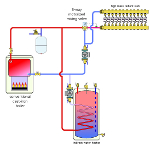A hydronic heating system from someone who doesn't want to learn 'a lot of unnecessary knowledge.'
The Glitch
I once read an online posting from a fellow who “just wanted to create a hydronic heating system without being dragged through a lot of unnecessary knowledge.” He decided that learning anything beyond soldering pipe and fittings together wasn’t worth his time. Let’s assume he created the system shown below.
Can you identify at least eight things that suggest he should have learned a bit more before picking up the pipe cutter and torch?
The Fix
There are a LOT of things wrong with the original design. Here’s a listing:
1. The individual circulators don’t have check valves to prevent flow reversal.
2. Both circulators are pumping toward the location of the expansion tank.
3. The inlets of both circulators are very close to other fittings that will cause increased turbulence. Always provide at least 12 pipe diameters of straight pipe upstream of the inlet to any circulator.
4. The circulator for the radiant panel manifold must be between the manifold and mixing valve to allow for mixing that creates the proper supply temperature.
5. The coil of the indirect water heater should always be piped with hot water entering the upper connection.
6. There is no backflow preventer, or shut-off valve within the feed water system.
7. There is no thermostatic tempering valve on the domestic hot water piping.
8. There are no purging valves or central air separator.
9. The mixing controller does not measure boiler inlet temperature, and thus cannot prevent sustained flue gas condensation.
10. The piping shown doesn’t provide the second mixing point needed to boost boiler inlet temperature and thus avoid sustained flue gas condensation.
The proper way to pipe a system with the same loads is shown to the left. The issues mentioned previously have all been addressed. Notice that a four-way motorized mixing valve operated by outdoor reset control is used.
Provided that there is relatively little head loss between the boiler and this valve, there is no need for a circulator between it and the boiler. The mixing point that boosts boiler inlet temperature is created within the four-way valve.



